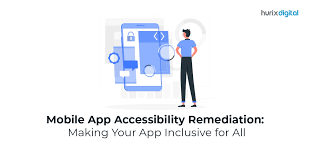I. Introduction
In our increasingly digital world, the concept of digital accessibility has become paramount. Ensuring that technology is inclusive for everyone, regardless of abilities or disabilities, is not just a matter of compliance but a fundamental step towards a more equitable and diverse technological landscape. This article explores the importance of digital accessibility, the challenges faced, and the strategies employed to make technology universally accessible.
II. Understanding Digital Accessibility
a. Defining Digital Accessibility
- Inclusive Design: Digital accessibility involves designing and developing digital content, services, and products in a way that is accessible to people of all abilities.
- Barrier Removal: It aims to eliminate barriers that might prevent individuals with disabilities from effectively using technology, ensuring equal access to information and functionalities.
b. Types of Disabilities Addressed
- Visual Impairments: Ensuring content is perceivable for those with visual impairments through screen readers and alternative text.
- Hearing Impairments: Providing captions and transcripts to make audio content accessible for individuals with hearing impairments.
- Motor Disabilities: Implementing keyboard-friendly interfaces and alternatives to mouse-based interactions.
III. The Significance of Digital Accessibility
a. Inclusive Participation
- Equal Opportunities: Digital accessibility provides equal opportunities for individuals with disabilities to participate in various online activities, from education to employment.
- Broader Market Reach: Making products and services accessible expands their reach, tapping into a broader market.
b. Legal and Ethical Imperatives
- Legal Compliance: Many countries have legal frameworks, such as the Americans with Disabilities Act (ADA), mandating digital accessibility.
- Ethical Responsibility: Beyond legal requirements, there is an ethical responsibility for organizations to ensure inclusivity and accessibility.
IV. Challenges in Achieving Digital Accessibility
a. Lack of Awareness
- Education and Awareness: Many individuals and organizations lack awareness about the importance and methods of achieving digital accessibility.
- Changing Perspectives: Shifting perspectives is crucial, understanding that digital accessibility is not just a compliance issue but a way to enhance user experience for everyone.
b. Rapid Technological Changes
- Keeping Pace: The fast-paced nature of technological advancements poses challenges in ensuring that new technologies are inherently accessible.
- Retrofitting Accessibility: Adapting existing technologies to be accessible requires additional efforts and resources.
V. Strategies for Digital Accessibility
a. Inclusive Design Principles
- User-Centric Approach: Incorporating a user-centric approach in design, understanding diverse user needs, and involving users with disabilities in the design process.
- Consistent and Intuitive Interfaces: Consistency and intuitiveness in design contribute to a more accessible user experience.
b. Assistive Technologies
- Screen Readers and Voice Commands: Employing technologies like screen readers and voice commands to assist users with visual or motor impairments.
- Captioning and Transcription Services: Providing captions and transcriptions for audio content ensures accessibility for individuals with hearing impairments.
VI. Future Trends in Digital Accessibility
a. AI and Machine Learning
- Automated Accessibility Testing: AI-driven tools can automate the process of accessibility testing, making it more efficient.
- Personalized Accessibility Features: Machine learning can enable personalized accessibility features based on individual user needs.
b. AR and VR Accessibility
- Enhanced Experiences: Augmented Reality (AR) and Virtual Reality (VR) technologies offer new ways to enhance accessibility and provide immersive experiences.
- Adaptive Interfaces: Designing adaptive interfaces in AR and VR environments for individuals with various disabilities.
VII. Conclusion
Digital accessibility is not just a compliance checkbox but a fundamental aspect of building a truly inclusive digital society. Overcoming challenges requires a collective effort from designers, developers, policymakers, and users. As technology continues to evolve, embracing digital accessibility becomes not only a necessity but a commitment to ensuring that the benefits of technology are accessible to all, irrespective of abilities.
FAQs
- Q: Why is digital accessibility important?
- A: Digital accessibility ensures that technology is inclusive for everyone, including individuals with disabilities, providing equal opportunities and expanding the reach of products and services.
- Q: What are the types of disabilities addressed in digital accessibility?
- A: Digital accessibility addresses various disabilities, including visual impairments, hearing impairments, and motor disabilities. It aims to make digital content and interfaces perceivable and usable for everyone.
- Q: What are the challenges in achieving digital accessibility?
- A: Challenges include lack of awareness, changing perspectives, and the rapid pace of technological advancements. Adapting existing technologies and educating stakeholders are essential components of achieving digital accessibility.
- Q: How can organizations promote digital accessibility?
- A: Organizations can promote digital accessibility by adopting inclusive design principles, incorporating assistive technologies, and raising awareness about the importance of accessibility. Ensuring that accessibility is part of the design process from the beginning is crucial.
- Q: What are the future trends in digital accessibility?
- A: Future trends include the integration of AI and machine learning for automated accessibility testing and personalized features. Additionally, advancements in AR and VR technologies offer new opportunities to enhance accessibility and create adaptive interfaces for individuals with disabilities.






